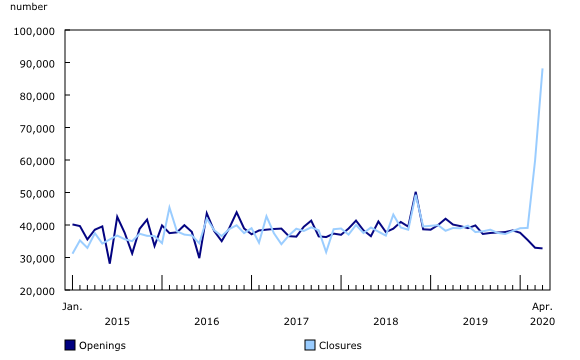Study: Monthly business openings and closures: Experimental series for Canada, the provinces and territories, and census metropolitan areas, 2015 to 2020
Archived Content
Information identified as archived is provided for reference, research or recordkeeping purposes. It is not subject to the Government of Canada Web Standards and has not been altered or updated since it was archived. Please "contact us" to request a format other than those available.
Released: 2020-08-05
New experimental series on monthly business openings and closures show that the COVID-19 pandemic has led to a significant increase in business closures and a decrease in business openings. In April 2020, 88,187 business closures were observed in the Canadian business sector, more than twice the level observed in April 2019. By comparison, openings declined by almost one-quarter over the same period.
The experimental series on monthly openings and closures, and the methods used to derive them, are described in the study "Monthly openings and closures: Experimental series for Canada, the provinces and territories, and census metropolitan areas," released today. The series include monthly estimates of the number of business openings and closures, continuing businesses, and active businesses from January 2015 to April 2020.
The series on monthly openings and closures supplement the annual and quarterly data that Statistics Canada produces on business entry and exit. While data on openings and closures are timelier, they are conceptually different from the data on entry and exit. Whereas a business can close and reopen within a year, a business can exit or enter only once. The concepts of entry and exit aim to capture permanent rather than temporary changes.
The COVID-19 pandemic has highlighted the need for both types of information. There is a need to know how many businesses have been immediately impacted by the COVID-19 shutdown and to track how many are reopening. The new experimental data on openings and closures address this gap.
Openings are defined as businesses with employment in the current month and no employment in the previous month, while closures are defined as businesses that had employment in the previous month, but no employment in the current month. Continuing businesses are those that have employees in both months, and the active population in any given month is the number of opening and continuing businesses in that month.
The estimates show that the increase in business closures in April 2020 was widespread across the provinces and territories. On a year-over-year basis, the largest increases occurred in Ontario (+149.7%), Quebec (+134.6%) and Nova Scotia (+127.7%).
A sharp increase in business closures was also recorded in Canada's three largest census metropolitan areas in April 2020 compared with the same month one year earlier. The largest increase was observed in Toronto (+13,771, or +154.6%), followed by Montréal (+4,812, or +139.9%) and Vancouver (+3,655, or +92.6%).
At the industry level, the largest increases in business closures from April 2019 to April 2020 occurred in accommodation and food services (+6,719, or +274.1%); other services (+6,814, or +264.3%), which include personal services; and retail trade (+6,133, or +217.7%).
Business openings declined in April, but not to the same degree as the increase in closures in the same month. There were 32,803 business openings in April 2020, a decrease of 18.3% compared with April 2019.
Note to readers
The monthly counts of openings and closures are based on businesses' employment. That is, a business is considered to be active if it has positive employment or payroll in a given month.
A business is defined as an enterprise operating in a particular geographic area and industry.
The vast majority of businesses operate in one industry and one location or geographic area. These businesses will be counted once at the national and provincial level in the monthly estimates of openings and closures. For example, a retailer in Windsor, Ontario, will be counted as an active business in the Ontario estimates and once in the national estimates.
Some businesses can have multiple operations, and these can be in different industries and geographic areas. These businesses can be counted more than once in the monthly estimates of openings and closures because they are active in multiple industries or geographic areas. For example, if a retailer has operations in both Alberta and Ontario, it will be counted as an active business in both provinces, but only once at the national level because it represents only one active firm. Similarly, a firm with retail and wholesale operations will be counted in both industries when individual industries are examined. However, when the business sector is examined, the firm will be counted only once because at that level it represents a single active firm.
Products
The research article titled Monthly Business Openings and Closures: Experimental Series for Canada, the Provinces and Territories, and Census Metropolitan Areas, part of the Economic Insights series (11-626-X), is now available.
Contact information
For more information, or to enquire about the concepts, methods or data quality of this release, contact us (toll-free 1-800-263-1136; 514-283-8300; STATCAN.infostats-infostats.STATCAN@canada.ca) or Media Relations (613-951-4636; STATCAN.mediahotline-ligneinfomedias.STATCAN@canada.ca).
- Date modified:


